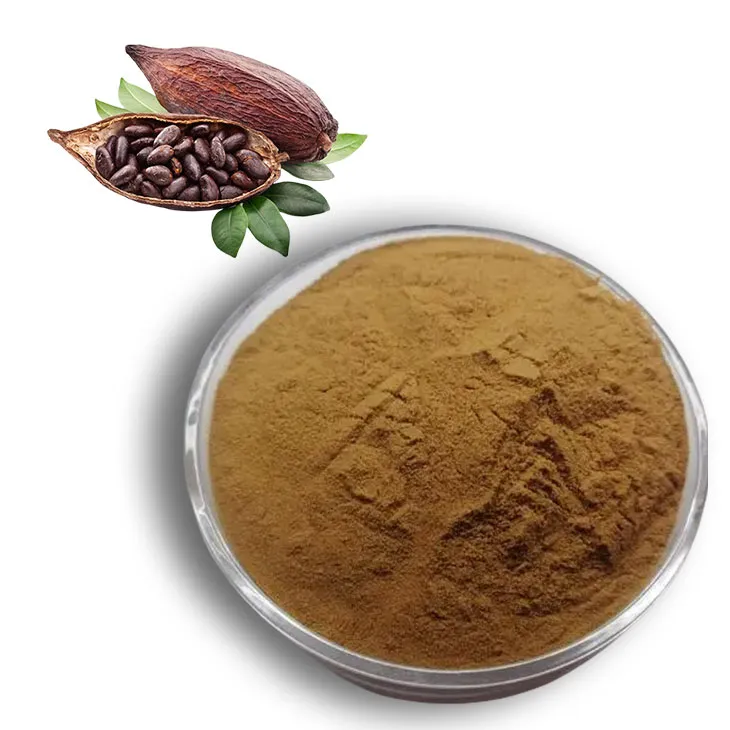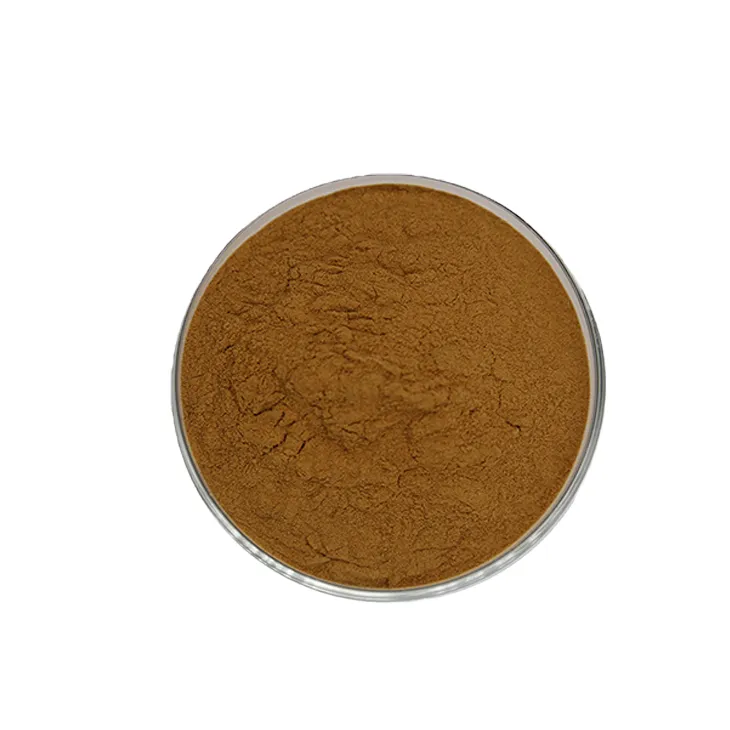- 0086-571-85302990
- sales@greenskybio.com
Benefits of cocoa extract in cattle feed.
2024-11-12

1. Introduction
In the field of animal husbandry, the search for natural and effective feed additives is an ongoing process. Cocoa Extract has emerged as a promising candidate for inclusion in cattle feed. This article will explore the multiple benefits that Cocoa Extract can bring to cattle, ranging from hormonal regulation to improved feed efficiency.

2. Hormonal Balance Regulation
Hormonal balance is crucial for the overall health and productivity of cattle. Cocoa Extract plays a significant role in this aspect.
2.1 Growth Hormone Influence
Growth hormones are essential for the proper development and growth of cattle. Cocoa extract contains certain bioactive compounds that can interact with the endocrine system of cattle. These compounds may stimulate the production or enhance the activity of growth hormones. For example, it could potentially influence the pituitary gland, which is a major regulator of growth hormones in the body. As a result, cattle may experience more efficient muscle development and skeletal growth. This is particularly important in the beef cattle industry, where maximizing growth rate can lead to higher yields and better economic returns.
2.2 Reproductive Hormone Effects
In terms of reproduction, cocoa extract can also have a positive impact. Reproductive hormones such as estrogen and progesterone play key roles in the estrous cycle and fertility of female cattle. The compounds in cocoa extract may help in maintaining the proper balance of these hormones. For instance, it could assist in regulating the length and regularity of the estrous cycle. In male cattle, it may influence testosterone levels, which are important for sperm production and libido. By promoting hormonal balance in both sexes, cocoa extract can contribute to improved reproductive performance in cattle herds, reducing the incidence of infertility and increasing the overall breeding success rate.

3. Natural Antibiotic Properties
The presence of flavonoids in cocoa extract endows it with natural antibiotic - like properties.
3.1 Antimicrobial Action
Flavonoids in cocoa extract can target a variety of harmful microorganisms. These include bacteria, viruses, and fungi that may infect cattle. For bacteria, the flavonoids can disrupt the cell membranes or interfere with their metabolic processes. For example, they may inhibit the synthesis of essential bacterial proteins or enzymes. This antimicrobial action can help in preventing and treating common infections in cattle, such as respiratory infections or gastrointestinal infections. By reducing the bacterial load in the body, the overall health of the cattle is improved, and they are less likely to suffer from diseases that can cause weight loss, reduced milk production (in dairy cattle), or even death.
3.2 Reducing Dependency on Artificial Drugs
In modern cattle farming, the use of artificial antibiotics is a common practice. However, over - use of these drugs can lead to problems such as antibiotic resistance. Cocoa extract offers an alternative. By using cocoa extract as a natural antibiotic in cattle feed, farmers can reduce their reliance on artificial drugs. This not only helps in preventing the development of antibiotic - resistant bacteria but also provides a more natural and sustainable approach to animal health management. Moreover, consumers are increasingly demanding products from animals that have been raised with minimal use of artificial drugs, and the use of cocoa extract can meet this market demand.

4. Improved Feed Conversion Ratios
The inclusion of cocoa extract in cattle feed can lead to better feed conversion ratios.
4.1 Appetite Stimulation
One of the ways cocoa extract improves feed conversion is by increasing the appetite of cattle. The unique flavor and aroma of cocoa extract can make the feed more appealing to cattle. Cattle are more likely to consume larger amounts of feed when it contains cocoa extract. This is important because increased feed intake is the first step towards better growth and productivity. For example, in a feedlot setting, where cattle are raised for beef production, ensuring that the animals eat well is crucial for achieving high - quality meat production.
4.2 Nutrient Utilization Enhancement
In addition to increasing appetite, cocoa extract also helps in better nutrient utilization. It contains
certain compounds that can enhance the digestive process in cattle. For instance, it may improve the function of
the rumen, which is a crucial part of the digestive system in cattle. By optimizing the rumen environment,
cocoa extract can promote the breakdown and absorption of nutrients such as proteins, carbohydrates, and
fats. This means that more of the nutrients in the feed are actually utilized by the cattle's body for growth,
milk production (in dairy cattle), or other physiological functions, rather than being excreted unused. As a
result, farmers can achieve better economic returns as they can get more output (meat, milk, etc.) from the
same amount of feed input.

5. Other Potential Benefits
Besides the above - mentioned main benefits, cocoa extract may also have other positive effects on cattle.
5.1 Antioxidant Activity
Cocoa extract is rich in antioxidants. These antioxidants can protect the cells of cattle from oxidative stress. In the body of cattle, normal metabolic processes generate reactive oxygen species (ROS). If the levels of ROS are too high, they can cause damage to cells, including DNA damage and lipid peroxidation. The antioxidants in cocoa extract can neutralize these ROS, thereby reducing cellular damage. This can contribute to the overall health and longevity of the cattle. For example, it may help in reducing the incidence of age - related diseases in cattle, allowing them to be more productive for a longer period of time.
5.2 Stress Reduction
Cattle can experience stress due to various factors such as environmental changes, handling procedures, or feed changes. Stress can have negative impacts on their growth, reproduction, and immune function. Cocoa extract may have stress - reducing properties. It could potentially influence the stress - response system in cattle, for example, by modulating the levels of stress hormones such as cortisol. By reducing stress in cattle, they can better adapt to their environment and farming conditions, resulting in improved performance and well - being.
6. Conclusion
In conclusion, cocoa extract has a wide range of benefits when included in cattle feed. From regulating hormonal balance to acting as a natural antibiotic, and from improving feed conversion ratios to providing other potential advantages such as antioxidant activity and stress reduction, it shows great potential in modern cattle farming. However, further research is still needed to fully understand the optimal dosage, long - term effects, and potential interactions with other feed components. With continued research and development, cocoa extract could become an important and widely - used feed additive in the future, contributing to more sustainable and efficient cattle production.
FAQ:
Q1: How does cocoa extract regulate the hormonal balance in cattle?
While the exact mechanism is not fully understood, it is believed that certain components in cocoa extract interact with the endocrine system in cattle. These components might affect the production or regulation of hormones related to growth and reproduction. However, more research is needed to precisely define how this regulation occurs at the molecular and physiological levels.
Q2: Are there any potential side effects of using cocoa extract in cattle feed?
As of now, there is no clear evidence of significant side effects. However, like any feed additive, it needs to be used in appropriate amounts. Excessive use could potentially lead to unforeseen issues. For example, if the flavonoids are present in very high concentrations, they might disrupt normal gut flora balance. Continued research and monitoring are important to ensure the long - term safety of using cocoa extract in cattle feed.
Q3: How do the flavonoids in cocoa extract act as natural antibiotics?
The flavonoids in cocoa extract have antioxidant and antimicrobial properties. They can inhibit the growth of certain harmful bacteria in the digestive tract of cattle. This is achieved through various mechanisms such as interfering with the bacterial cell wall synthesis or disrupting the bacterial metabolism. By reducing the number of harmful bacteria, they help keep the cattle healthy, much like traditional antibiotics, but in a more natural way.
Q4: Can cocoa extract improve the quality of beef or dairy products?
There is potential for cocoa extract to improve the quality of beef and dairy products. Since it can improve the overall health and growth of cattle, it may lead to better - quality meat and milk. For example, if cattle are healthier and have better nutrient utilization, the composition of the milk, such as its fat and protein content, may be optimized. In terms of beef, factors like marbling and tenderness could potentially be enhanced, but more research is required to confirm these effects.
Q5: How much cocoa extract should be added to cattle feed?
The appropriate amount of cocoa extract to add to cattle feed depends on various factors such as the age, weight, and health status of the cattle, as well as the composition of the rest of the feed. Currently, there are no standardized guidelines, but initial research suggests starting with small amounts, perhaps around 1 - 2% of the total feed weight, and then adjusting based on the observed effects on the cattle's growth, health, and productivity. It is crucial to conduct further studies to establish optimal dosage levels.
Related literature
- The Role of Cocoa Extract in Animal Nutrition"
- "Cocoa Flavonoids and Their Impact on Cattle Health"
- "Beneficial Effects of Cocoa - Based Additives in Cattle Feed"
- ▶ Hesperidin
- ▶ citrus bioflavonoids
- ▶ plant extract
- ▶ lycopene
- ▶ Diosmin
- ▶ Grape seed extract
- ▶ Sea buckthorn Juice Powder
- ▶ Beetroot powder
- ▶ Hops Extract
- ▶ Artichoke Extract
- ▶ Reishi mushroom extract
- ▶ Astaxanthin
- ▶ Green Tea Extract
- ▶ Curcumin Extract
- ▶ Horse Chestnut Extract
- ▶ Other Problems
- ▶ Boswellia Serrata Extract
- ▶ Resveratrol Extract
- ▶ Marigold Extract
- ▶ Grape Leaf Extract
- ▶ blog3
- ▶ blog4
- ▶ blog5
-
Organic Tongkat Ali extract powder factory.
2024-11-12
-
How to make powder with ashwagandha extract.
2024-11-12
-
Rosehip extract manufacturers from China.
2024-11-12
-
The best cat's claw extract in nature.
2024-11-12
-
Chinese Dandelion Leaf Extract Suppliers.
2024-11-12
-
Purple Sweet Potato Extract
2024-11-12
-
Nutmeg Extract
2024-11-12
-
Lotus leaf extract
2024-11-12
-
Red Wine Extract
2024-11-12
-
Black Rice Extract
2024-11-12
-
Grapefruit Seed Extract Powder
2024-11-12
-
Bamboo Leaf extract
2024-11-12
-
Yellow Pine Extract
2024-11-12
-
Boswellia Serrata Extract
2024-11-12
-
Resveratrol extract
2024-11-12





















